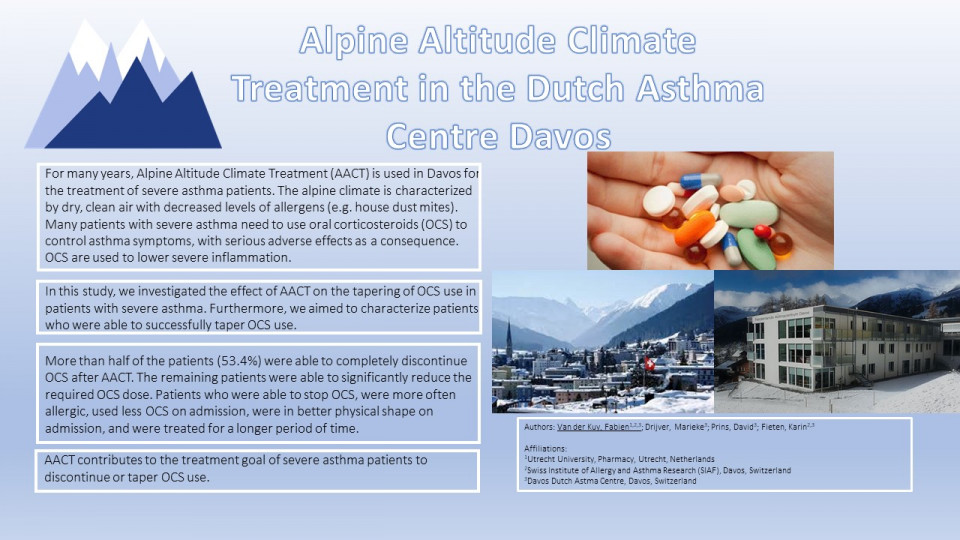Introduction:
For many years Alpine Altitude Climate Treatment (AACT) is used in the treatment of severe asthma patients. The alpine climate is characterized by dry, clean air with decreased levels of allergens (e.g. house dust mites). Some studies already demonstrated the beneficial effects of AACT. Many patients with severe asthma need to use oral corticosteroids (OCS) to control asthma symptoms, with serious adverse effects as a consequence. Therefore, a treatment goal of AACT is often to taper OCS use. However, evidence on tapering OCS is limited.
Study aim:
To investigate the effect of AACT on the tapering of OCS use in patients with severe asthma. Furthermore we aim to characterize patients who were able to successfully taper OCS use.
Methods:
In this retrospective observational study 156 patients with severe asthma were included. These patients were under treatment in the Dutch Asthma Centre in Davos (1600 metres above sea-level) for 8-12 weeks, between 2019-2021. All patients were tested on admission and on discharge. Data was extracted from the digital patient file. Patients were evaluated on asthma phenotype (allergic, eosinophil, late/early onset), OCS use, asthma-related quality of life (Asthma-related Quality of Life Questionnaire, AQLQ), asthma control (Asthma Control Questionnaire, ACQ), sino-nasal symptoms (Sino-Nasal Outcome test, SNOT-22), lung function (Forced Expiratory Volume in one second, FEV1), exercise capacity (shuttle walk test), allergic sensitization (serum IgE levels) and inflammation (fraction of exhaled nitric oxide, serum eosinophil levels).
Results:
We included 156 patients (67% female, 64% early onset, 76% allergic, 49% eosinophil phenotype). The mean age was 49 years. At baseline 69 of the 156 patients (44%) needed OCS chronically. After treatment, 33 out of 69 patients (48%) could completely discontinue OCS use (p<0.001). Additionally, the maintenance doses OCS of the remaining patients were significantly reduced (14.3 mg to 7.25 mg, p<0.001).
Discussion/conclusion:
Maintenance OCS use is associated with several side effects. Therefore the reduction of OCS use is important for patients with severe asthma. Almost half of the patients (48%) were able to completely discontinue OCS after AACT. The remaining patients were able to significantly reduce the required OCS dose. Tapering OCS is especially relevant for patients with high OCS dose.. AACT contributes to the treatment goal of severe asthma patients to discontinue or taper OCS use.
